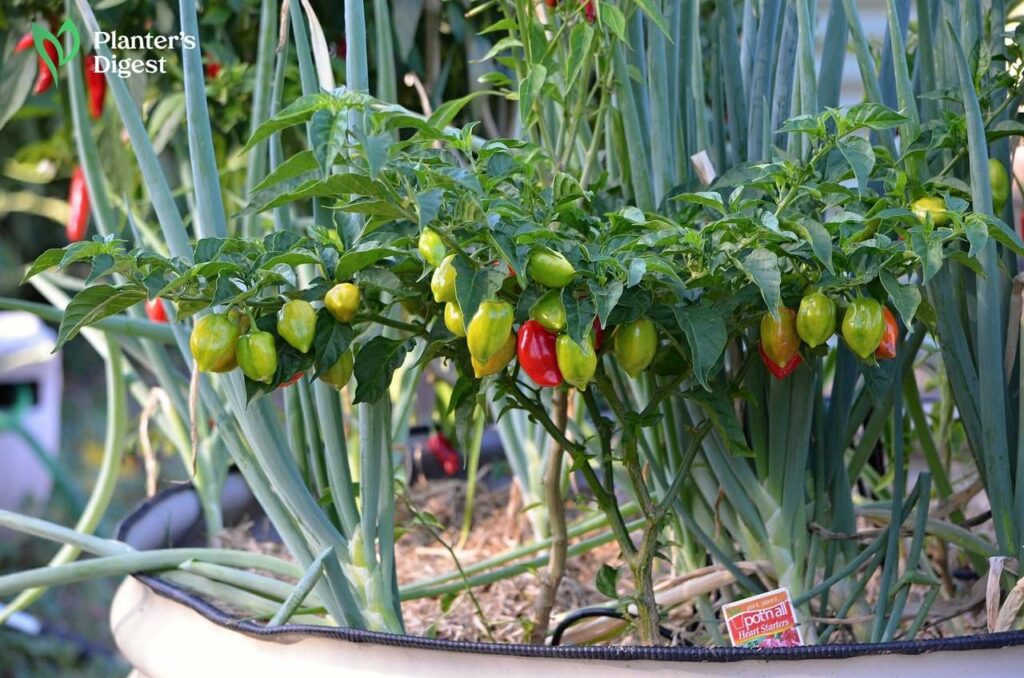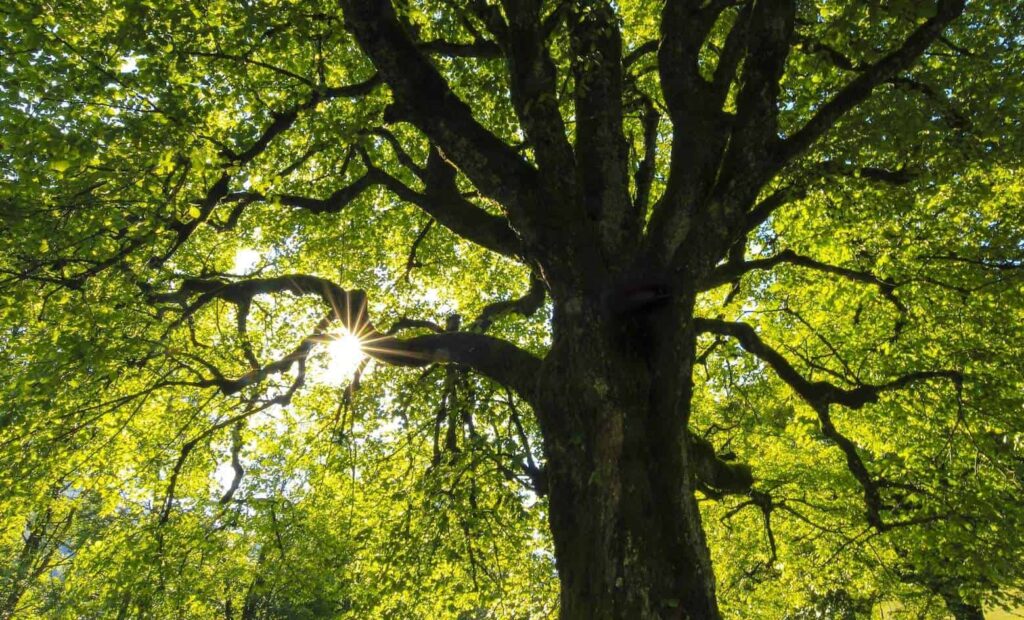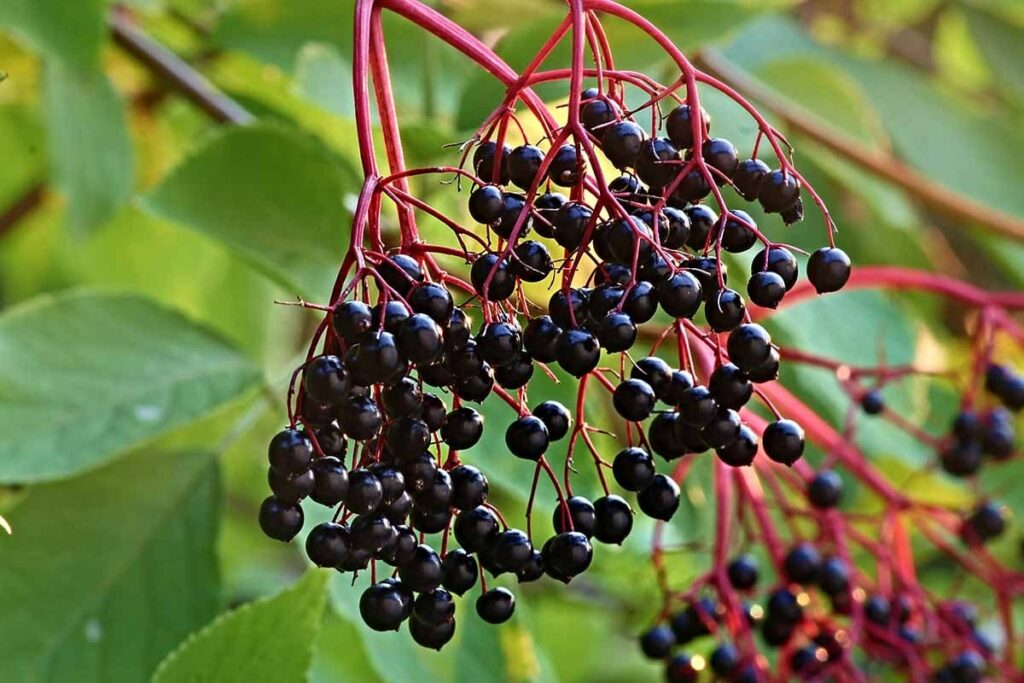Pepper plants, whether sweet or spicy, add a burst of flavor and color to kitchens and gardens. While they may seem like low-maintenance plants, most pepper plants still need extra care to thrive and not fall over.
Fortunately, we’re here to walk you through the most effective ways to support pepper plants with bonus tips and tricks to keep them healthy. Keep reading to learn how to keep pepper plants from falling over and increase your harvest!
Do pepper plants need support?
Pepper plants need support to help them cope with their tall, leggy growth and weight due to fruit production. Different support systems prevent the pepper plant from leaning sideways or falling to the ground.
Common signs that indicate a pepper plant needs support include dropping branches and snapping stems that fall to the ground.
It’s best to start supporting pepper plants while they’re still young because this will keep your pepper plants healthy, get bigger and have a more bountiful harvest.
This way, instead of exerting energy to keep its stems upright, the pepper plant can focus on growing a healthy root system, foliage and fruit production.
Why should you support pepper plants?
Supporting pepper plants help prevent damage from wind, ensures optimal distribution of sunlight and air, and reduces the risk of pest infestations and diseases.
1. Supporting pepper plants prevent diseases.
Since pathogens live in the soil and moist areas at the base of plants, there is an increased risk for pepper plants to contract fungal, bacterial or viral diseases when their leaves and stems droop or come in contact with the ground.
So, adding support structures to keep pepper plants upright will limit contact with the soil leading to lesser chances of rotting or contracting plant diseases.
2. Supporting pepper plants help increase yield.
With added support, pepper plants are less likely to break under the weight of their fruit or in windy conditions, ensuring a healthy and ample harvest.
3. Supporting pepper plants improves air circulation and access to sunlight.
When plants have better air circulation, there’s a reduced risk of diseases and pests. Providing support also gives them more sunlight, improving photosynthesis and overall growth.
What makes pepper plants fall over?
Pepper plants fall to the ground because of a lack of water, diseases and heavy foliage.
Let’s discuss each cause and how to treat or prevent them besides adding support structures.
1. Lack of Water
| How to Fix | Water the pepper plant regularly. |
Turgor pressure in pepper plants is maintained when it receives adequate water. As a result, turgor pressure helps keep plant cells and their stems upright, or the plant will limp, wilt and collapse.
The good news is that dehydrated pepper plants will come back to life with excellent and regular watering.
We recommend you check your soil daily using your fingers to check the water level. Water your pepper plant immediately if the soil is dry to touch or bone dry.
If you live in areas with warm climates or during summer, water your pepper plants more frequently to make sure that they get enough water to beat the scorching heat.
2. Diseases
| How to Fix | Add support structures to the pepper plant. |
Common pepper plant diseases such as root rot and fusarium wilt cause the plant to fall over and spread the infection to other plants in your garden.
The sad news is that once these fungi, bacteria and viruses infect your plant, there’s nothing much that you can do then uproot your pepper plant.
Still, prevention is better than cure, and preventing the stems, leaves and fruits from touching the ground is one of the most effective ways. To do this, you should add support structures to keep the pepper plant off the ground.
3. Heavy Foliage
| How to Fix | Prune pepper plant regularly. |
When pepper plants grow too many leaves, they lean to the ground because of their heavy weight. So to keep them upright, you should prune excess leaves to relieve the plant of some weight and prevent it from dropping.
Regular pruning also helps promote the growth of bigger and more peppers and boost their ripening process. It also gives the plant more access to sunlight and allows it to divert its energy toward producing fruits than growing leaves.
We recommend that you trim the branches around the bottom of the plant, then prune up to eight inches of leaves from the bottom. For younger pepper plants, start by pruning three to four inches from the base.
How do you keep pepper plants from falling over?
The best way to keep pepper plants from falling over is by adding a support structure to aid their growth. These support structures include stakes, cages, trellises, ropes, and Florida weaves.
Let’s dive deeper into the benefits of each support structure to your pepper plants and how to add them to your garden.
1. Stakes
Using stakes as a support structure involves inserting a stake beside the plant and gently tying the main stem to it. This supports the main stem, helping to keep the plant upright and preventing damage to the pepper root system.
Since most pepper plants grow approximately three feet tall, a four-foot stake is a good standard, where one foot is below, and the rest is above the ground. You can use bamboo, wood, metal, or plastic stakes for your pepper plants.
We also recommend that you stake your pepper plants early in the planting season so you won’t damage the roots when you drive the stakes in the soil close to the already established plant.
Here are two ways to apply the staking technique to pepper seedlings and mature plants.
On Pepper Seedlings
| Difficulty | Easy ●○○○○ |
| Duration | 1 to 2 hours |
| Things You Need | Pepper Seedling Cooking skewers, popsicle sticks, or twigs as stakes Twine or velcro clip |
Pepper seedlings tend to grow legging when they do not get enough sunlight. As a result, their stems grow tall quickly but become thin, fragile and weak.
To keep pepper seedlings standing tall, move them into an area with more sunlight and add stakes for extra support. Below are steps on how to stake pepper seedlings.
How to Do
• Gently place the stake of your choice next to each pepper seedling.
• Do not pierce its newly-grown roots. Attach the seedling to the stake using a twine or velcro clip.
• Do not tie it too tight to prevent suffocation of the plant as it grows bigger over time.
On Pepper Plants
| Difficulty | Easy ●○○○○ |
| Duration | 1 to 2 hours |
| Things You Need | Pepper Plant Wood, metal, or bamboo stakes Twine or string |
Staking mature pepper plants is the same as staking seedlings. It’s just that this time, you’ll have to use bigger and sturdier support structures, such as those made of wood, metal or bamboo.
In using wood, ensure they’re not treated with harsh chemicals because this can transfer to your garden bed or plant and cause poisoning.
Below are easy steps on how to stake mature pepper plants.
How to Do
• Choose a suitable stake, approximately 1 to 2 inches in diameter and 3 to 4 feet tall.
• They should be around 5 feet tall to support even the tallest pepper plant.
• Drive the stake about 8 to 12 inches deep into the ground, 3 to 4 inches from the plant base.
• As the plant grows, gently tie the main stem to the stake with soft, flexible twine or strings.
• Add more soft ties to secure and grow pepper plants at regular intervals.
• Do not constrict the stem or cause damage.
2. Cages
| Difficulty | Easy ●○○○○ |
| Duration | 1 to 2 hours |
| Things You Need | Pepper Plant Wire, metal, wood cage |
Cages offer pepper plants a more encompassing support system, especially with bushy growth and heavier fruits.
They surround the plant with an upright frame, usually made of metal or wood, where the branches can grow to support themselves without constraining their growth. It also prevents pepper plants from escaping and sprawling on the ground.
Check out these steps on how to use cages on your pepper plants.
How to Do
• Purchase or build a sturdy cage to accommodate your pepper plants’ mature size.
• Install the cage over the plant. Make sure it is centered and securely anchored in the ground.
• Guide the plant’s branches through the cage openings as it grows to prevent tangling.
3. Trellises
| Difficulty | Easy ●○○○○ |
| Duration | 1 to 2 hours |
| Things You Need | Pepper Plant Wire or string Pruning shears |
Trellises involve using more ornate structures to hold up the plants. This is an excellent option for those with limited space or who want to add an aesthetic element to their garden.
With this method, you’ll train the pepper plant to grow along a horizontal wire or string, encouraging better air circulation and sunlight exposure. Just make sure the pepper plants have enough space in between so you don’t disturb their roots.
How to Do
• Install horizontal wires or strings between sturdy posts about 12 to 18 inches apart, parallel to the ground.
• As the plant grows, gently guide its branches along the wires or strings, securing them with soft ties.
• Prune excessive growth to maintain a manageable plant size and encourage healthy fruit development.
4. Ropes
| Difficulty | Easy ●○○○○ |
| Duration | 1 to 2 hours |
| Things You Need | Pepper Plant Wood, metal, or bamboo stakes Twine or string |
Ropes are a simple yet effective method to maintain stability and support in your pepper plants, ensuring they remain strong and healthy throughout the growing season.
This setup is suitable for smaller plants and big sprawling bell peppers. It also helps pepper cope with heavy winds as the pepper plants move naturally with the current using a flimsier rope structure.
Here are steps on how to use ropes on pepper plants.
How to Do
• Install a stake or post next to each pepper plant.
• The stake should be roughly the same height as the mature plant.
• As the pepper plant grows, loosely tie the rope around its main stem and tie it to the stake.
• Make sure the loop is loose enough to avoid damaging the stem and leave some room for the stem to grow and expand.
• Add loops of rope around the plant and stake as needed, Maintaining a six to eight-inch interval between each loop.
• Secure heavy branches by tying a piece of twine around the heavy branch and securing it to the stake.
• Keep a close eye on your pepper plants throughout the growing season and adjust the ropes or twine as needed to ensure proper support without constriction.
5. Florida Weave
| Difficulty | Easy ●○○○○ |
| Duration | 1 to 2 hours |
| Things You Need | Pepper Plant Wood, metal, or bamboo stakes Twine or string |
The Florida Weave method is another efficient and affordable method most gardeners use to grow peppers. This technique encourages healthy growth and makes pepper plants more productive.
The Florida Weave is also popular for supporting various plants, including tomatoes, peppers, eggplants, and other tall or heavy fruit-bearing plants.
Below are steps on how to apply the Florida Weave method on your pepper plants.
How to Do
• Place sturdy stakes or t-posts approximately five to six feet apart along the row of plants.
• Make sure they’re deep enough for stability and placed at both ends of the row.
• Begin the weaving process on one end of the row.
• Stand at the base of the first stake on the outer side of the row.
• Tie the twine to the stake about 8 to 12 inches above the ground.
• As you move along the row, gently loop the twine around the plants, keeping it on the outside of the first plant.
• Guide the twine to the next stake, pulling it tight and keeping it at the same height.
• Wrap the twine around the stake before continuing along the row.
• Weave the opposite side of the row beginning from the first stake.
• Once done with both sides, wrap the twine or string multiple times around the last stake, and secure it with a knot.
• As the plants grow, add more layers of Florida Weave.
• A new layer is needed every 7 to 10 days, depending on the growth rate.
• Space the layers about 8 to 12 inches apart vertically.
• Adjust the previous layers as needed to prevent constriction on the plants.
• Regularly check the weave and tighten or adjust it as necessary, ensuring the plants are supported appropriately without causing damage or constraint.
How to Protect Pepper Plants from the Wind
Now that your pepper plants are properly supported, your next obstacle is the strong wind. While light wind can benefit pepper plants by strengthening stems and increasing transpiration, rough wind can cause drying out of the plant or even uprooting them.
To protect pepper plants from the damaging effects of rough wind, you can build a windbreak, wall or greenhouse.
Read on to learn how to protect your pepper plants from the wind.
1. Windbreak
| Difficulty | Easy ●○○○○ |
| Duration | 1 to 2 hours |
| Things You Need | Pepper Plant Measuring tools Posts Fence Shrubs Trees Gardening spade or trowel Watering pot |
A windbreak may be one or more rows of plants to reduce wind impact on the plants in an area, such as hedgerows, fences, shrubs, or trees. Generally, windbreaks should be taller than the crops they protect and positioned perpendicular to the prevailing winds.
They are crucial barriers against the wind, as they reduce wind velocity and protect your pepper plants from wind-induced stress and damage, such as broken stems, torn leaves, or even complete uprooting.
Here are steps on how to install a windbreak.
How to Do
• Measure the area where the windbreak will be placed.
• Purchase or gather your materials (fence, shrubs, trees).
• For fences, install posts along the measured line at regular intervals.
• Attach the fence material securely to the posts.
• For shrubs or trees, dig holes regularly and plant each shrub or tree deeply enough to cover the root ball.
• Water thoroughly after planting.
2. Wall
| Difficulty | Easy ●○○○○ |
| Duration | 1 to 2 hours |
| Things You Need | Pepper Plant Garden spade or trowel Bricks or stones |
High winds can wreak havoc in your garden. A well-built garden wall or barrier can be a game-changer, shielding strong winds, enhancing privacy, and even reducing noise pollution.
The garden wall can be a fence, or living hedge, taking into account their aesthetic effect, functionality, and maintenance requirements. You can also grow crops such as potatoes or add straw bales inside to strengthen the wind barrier.
Below are the steps to building a wall that protects pepper plants from harsh winds.
How to Do
• Remove any obstacles and mark the boundaries for your garden wall or barrier.
• Dig a trench, remove debris, and level the ground to create a solid base.
• Establish a firm footing by pouring concrete or laying a layer of sturdy materials, like bricks or stones, in the trench.
• Assemble the wall or barrier layer by layer, ensuring each level is stable and secure.
• Refine the structure’s appearance and test its stability.
3. Greenhouse
Imagine increasing your pepper productivity by 25% and improving plant health by creating an ideal growing environment. It might sound like a fantasy, but it’s possible with greenhouses!
Greenhouses offer a sheltered space that provides optimum environmental conditions for pepper plants, including strong wind. They efficiently shield your peppers from harsh weather, pests, and diseases—contributing to promising yields.
With greenhouses, you can control the temperature and humidity, leading to healthier plants and higher yields. They also provide a barrier against pests and diseases and reduce plant stress overall.
FAQs on Support for Pepper Plants
Hot pepper plants such as jalapeno, habanero and poblano need support because of their heavy fruit and high yield. On the other hand, small pepper varieties like chili or shishito can hold their weight even without support structures.
Jalapeno peppers need support because of their heavy fruit loads and for protection against harsh winds, pests and diseases.
Pepper plants do not climb because they are not vining plants. Although they can grow upright, they usually need support to help carry the weight of their fruit yield.
Pepper plants should be regularly pruned to help improve their access to sunlight and air circulation and focus their energy on producing fruits.
Cutting the top of the pepper plant is advisable to spur bushier growth, increase fruit yield, and maintain a manageable plant size.





